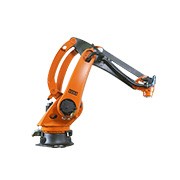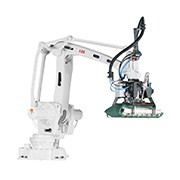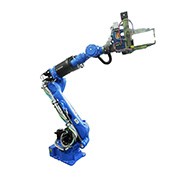In 2018, the smoke is getting stronger. A number of domestic smart manufacturing policies have been introduced to promote the transformation and upgrading of the manufacturing industry, which undoubtedly created a new favorable environment for the development of domestic robots. And internationally, the demand is still strong. So, how did the domestic and foreign robotics companies perform in the past six months?
Foreign companies
Looking at the financial reports of foreign companies, the overall growth is in the trend, which shows that the market capacity is still huge, so all parties continue to increase investment in local and overseas, acquisitions, mergers, and detachment frequently, and China is undoubtedly their most important Land of contention.
ABB
In the first six months of 2018, ABB achieved sustained profitable growth. Among them, sales income was 17.516 billion US dollars, up 7% year-on-year in 2017; net profit was 1.253 billion US dollars, which was basically the same as the profit of 1.249 billion US dollars in the first half of 2017.
Thanks to ABB's continued focus on specific industries such as food and beverage, automotive and 3C, ABB's robotics business has shown steady growth since this year.
Yaskawa Electric
As of May 31, 2018, Yaskawa Electric had sales of 236.889 billion yen and net income of 25.816 billion yen.
Yaskawa Electric adjusted its financial reporting period this year, so the quarterly and semi-annual reports did not indicate a year-on-year change. Yaskawa Electric's sales in the first quarter (March 1, 2018-May 31, 2018) were 128.216 billion yen, and the net profit attributable to shareholders of the parent company was 15.718 billion yen.
In the first quarter financial report of Yaskawa Electric, robot sales were 43.913 billion yen and operating income was 5.05 billion yen. The company believes that the market is performing well. Among them, the demand for welding and painting robots for the automotive industry is strong, and rapid development has been achieved in Japan and Europe. The demand for manufacturing automation centered on China is still very strong, and the trend is improving.
Fanuc
As of June 30, 2018, FANUC's total revenue for the first half of this year was 373.437 billion yen; operating income was 113.879 billion yen, net income was 90.367 billion yen, and the net profit TTM (rolling price-earnings ratio for the past 12 months) index was 25.15%.
Kuka
In the first half of this year, KUKA's total sales were 1.597 billion euros; operating income was 67 million euros. Net profit attributable to shareholders of the parent company was 51 million euros and the net profit TTM index was 2.39%.
After the acquisition of KUKA by Midea, Wen Qiming, CEO of KUKA General Industrial China, stated that KUKA's goal is to become the No.1 robot manufacturer in China by 2020. In 2017, KUKA's total revenue was about the Chinese market. 20%, with a total revenue of 3.479 billion euros.
Mitsubishi
In the first six months of 2018, Mitsubishi Electric achieved total revenue of 2,376.168 billion yen, and the net profit attributable to shareholders of the parent company was 126.340 billion yen.
Alphabet
Google parent company Alphabet's profit statement shows that in the first half of this year, total revenue was 63.803 billion US dollars; net profit was 12.596 billion yuan. Its second-quarter earnings report showed that second-quarter revenue was 32.66 billion US dollars, a significant increase of 26% year-on-year.
Domestic enterprises
Different from the continuous large-scale investment of foreign companies, local companies prefer to form strategic alliances with companies in other fields in the country, and seek development through win-win cooperation.
Eston
It is estimated that the net profit attributable to shareholders of Estun listed companies from January to June 2018 will be 52.152 million to 72.221 million yuan, an increase of 30% to 80% year-on-year. In 2017, Eston's operating income was 1,077 million yuan, a significant increase of 58.69% year-on-year. Compared with 2015, revenue has doubled.
New Shida
Xinshida released a performance forecast, and it is estimated that the net profit attributable to shareholders of listed companies from January to June 2018 will be 14.88 million-56.56 million yuan, a year-on-year decrease of 85% -45%.
Shinsong Robot
The semi-annual performance forecast for 2018 shows that the net profit attributable to ordinary shareholders of listed companies is 209 million to 244 million yuan, an increase of 18% to 38% over the same period last year.
Tostar
Tuosda's performance forecast shows that from January 1 to June 30, 2018, the net profit attributable to shareholders of listed companies was 70 million to 81 million yuan, an increase of 28.01% -48.13% over the same period of the previous year.
Central China CNC
It is expected that the net profit attributable to shareholders of listed companies from January to June 2018 will be 44.69 million to 46.69 million yuan, a year-on-year change of -1713.47% to -1551.12%. The average net profit growth rate of the general equipment industry will be 10.54%.
Central China CNC can be said to be a bit of green in the long-term red market of robot companies. The main reason for the loss disclosed by the company is that the current debtor reorganization will expose the company to the risk of irrecoverable receivables and impairment of available-for-sale financial assets. Based on the principle of prudence, the company will supplement the above receivables. Provision for bad debts of receivables was 22.39996 million yuan, and provision for impairment of available-for-sale financial assets was 8.976 million yuan. The total of the above provisions will affect the company's profit for the first half of 2018 of 31.764 million yuan.

 中文版
中文版







